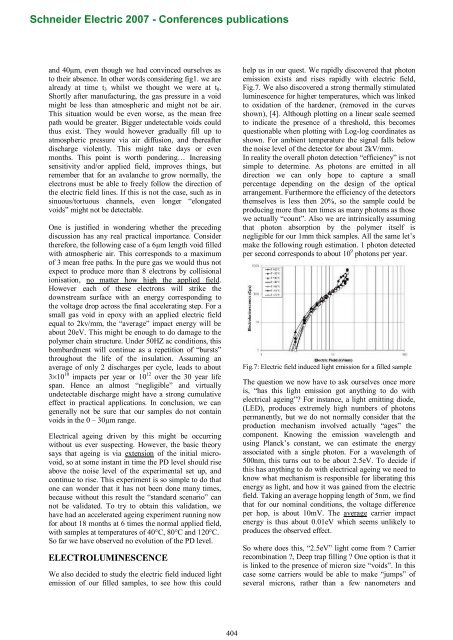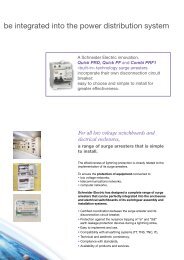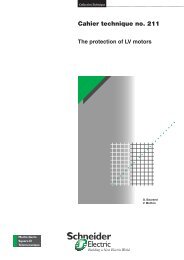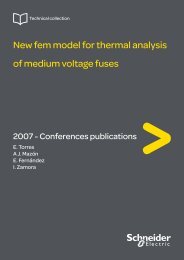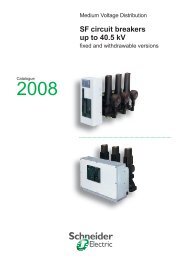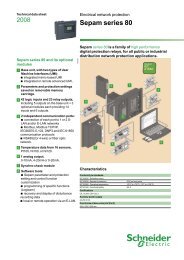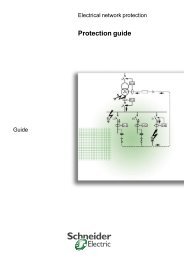Electrical ageing of composites: an industrial ... - Schneider Electric
Electrical ageing of composites: an industrial ... - Schneider Electric
Electrical ageing of composites: an industrial ... - Schneider Electric
You also want an ePaper? Increase the reach of your titles
YUMPU automatically turns print PDFs into web optimized ePapers that Google loves.
<strong>Schneider</strong> <strong>Electric</strong> 2007 - Conferences publications<strong>an</strong>d 40µm, even though we had convinced ourselves asto their absence. In other words considering fig1. we arealready at time t 3 whilst we thought we were at t 0 .Shortly after m<strong>an</strong>ufacturing, the gas pressure in a voidmight be less th<strong>an</strong> atmospheric <strong>an</strong>d might not be air.This situation would be even worse, as the me<strong>an</strong> freepath would be greater. Bigger undetectable voids couldthus exist. They would however gradually fill up toatmospheric pressure via air diffusion, <strong>an</strong>d thereafterdischarge violently. This might take days or evenmonths. This point is worth pondering… Increasingsensitivity <strong>an</strong>d/or applied field, improves things, butremember that for <strong>an</strong> aval<strong>an</strong>che to grow normally, theelectrons must be able to freely follow the direction <strong>of</strong>the electric field lines. If this is not the case, such as insinuous/tortuous ch<strong>an</strong>nels, even longer “elongatedvoids” might not be detectable.One is justified in wondering whether the precedingdiscussion has <strong>an</strong>y real practical import<strong>an</strong>ce. Considertherefore, the following case <strong>of</strong> a 6µm length void filledwith atmospheric air. This corresponds to a maximum<strong>of</strong> 3 me<strong>an</strong> free paths. In the pure gas we would thus notexpect to produce more th<strong>an</strong> 8 electrons by collisionalionisation, no matter how high the applied field.However each <strong>of</strong> these electrons will strike thedownstream surface with <strong>an</strong> energy corresponding tothe voltage drop across the final accelerating step. For asmall gas void in epoxy with <strong>an</strong> applied electric fieldequal to 2kv/mm, the “average” impact energy will beabout 20eV. This might be enough to do damage to thepolymer chain structure. Under 50HZ ac conditions, thisbombardment will continue as a repetition <strong>of</strong> “bursts”throughout the life <strong>of</strong> the insulation. Assuming <strong>an</strong>average <strong>of</strong> only 2 discharges per cycle, leads to about3×10 10 impacts per year or 10 12 over the 30 year lifesp<strong>an</strong>. Hence <strong>an</strong> almost “negligible” <strong>an</strong>d virtuallyundetectable discharge might have a strong cumulativeeffect in practical applications. In conclusion, we c<strong>an</strong>generally not be sure that our samples do not containvoids in the 0 – 30µm r<strong>an</strong>ge.<strong><strong>Electric</strong>al</strong> <strong>ageing</strong> driven by this might be occurringwithout us ever suspecting. However, the basic theorysays that <strong>ageing</strong> is via extension <strong>of</strong> the initial microvoid,so at some inst<strong>an</strong>t in time the PD level should riseabove the noise level <strong>of</strong> the experimental set up, <strong>an</strong>dcontinue to rise. This experiment is so simple to do thatone c<strong>an</strong> wonder that it has not been done m<strong>an</strong>y times,because without this result the “st<strong>an</strong>dard scenario” c<strong>an</strong>not be validated. To try to obtain this validation, wehave had <strong>an</strong> accelerated <strong>ageing</strong> experiment running nowfor about 18 months at 6 times the normal applied field,with samples at temperatures <strong>of</strong> 40°C, 80°C <strong>an</strong>d 120°C.So far we have observed no evolution <strong>of</strong> the PD level.ELECTROLUMINESCENCEWe also decided to study the electric field induced lightemission <strong>of</strong> our filled samples, to see how this couldhelp us in our quest. We rapidly discovered that photonemission exists <strong>an</strong>d rises rapidly with electric field,Fig.7. We also discovered a strong thermally stimulatedluminescence for higher temperatures, which was linkedto oxidation <strong>of</strong> the hardener, (removed in the curvesshown), [4]. Although plotting on a linear scale seemedto indicate the presence <strong>of</strong> a threshold, this becomesquestionable when plotting with Log-log coordinates asshown. For ambient temperature the signal falls belowthe noise level <strong>of</strong> the detector for about 2kV/mm.In reality the overall photon detection “efficiency” is notsimple to determine. As photons are emitted in alldirection we c<strong>an</strong> only hope to capture a smallpercentage depending on the design <strong>of</strong> the opticalarr<strong>an</strong>gement. Furthermore the efficiency <strong>of</strong> the detectorsthemselves is less then 20%, so the sample could beproducing more th<strong>an</strong> ten times as m<strong>an</strong>y photons as thosewe actually “count”. Also we are intrinsically assumingthat photon absorption by the polymer itself isnegligible for our 1mm thick samples. All the same let’smake the following rough estimation. 1 photon detectedper second corresponds to about 10 9 photons per year.Fig.7: <strong>Electric</strong> field induced light emission for a filled sampleThe question we now have to ask ourselves once moreis, “has this light emission got <strong>an</strong>ything to do withelectrical <strong>ageing</strong>”? For inst<strong>an</strong>ce, a light emitting diode,(LED), produces extremely high numbers <strong>of</strong> photonsperm<strong>an</strong>ently, but we do not normally consider that theproduction mech<strong>an</strong>ism involved actually “ages” thecomponent. Knowing the emission wavelength <strong>an</strong>dusing Pl<strong>an</strong>ck’s const<strong>an</strong>t, we c<strong>an</strong> estimate the energyassociated with a single photon. For a wavelength <strong>of</strong>500nm, this turns out to be about 2.5eV. To decide ifthis has <strong>an</strong>ything to do with electrical <strong>ageing</strong> we need toknow what mech<strong>an</strong>ism is responsible for liberating thisenergy as light, <strong>an</strong>d how it was gained from the electricfield. Taking <strong>an</strong> average hopping length <strong>of</strong> 5nm, we findthat for our nominal conditions, the voltage differenceper hop, is about 10mV. The average carrier impactenergy is thus about 0.01eV which seems unlikely toproduces the observed effect.So where does this, “2.5eV” light come from ? Carrierrecombination ?, Deep trap filling ? One option is that itis linked to the presence <strong>of</strong> micron size “voids”. In thiscase some carriers would be able to make “jumps” <strong>of</strong>several microns, rather th<strong>an</strong> a few n<strong>an</strong>ometers <strong>an</strong>d404


